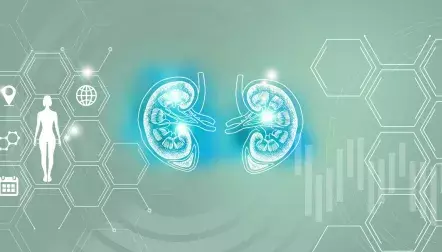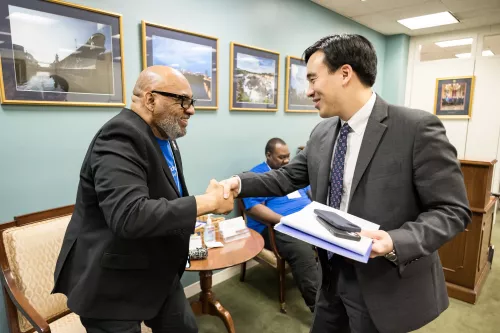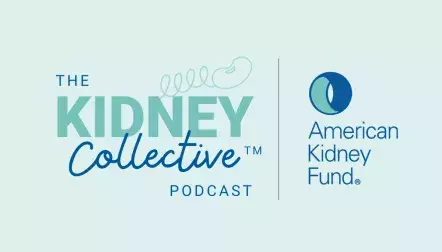
The Need for a CKD Screening Recommendation
The American Kidney Fund (AKF) is urging the U.S. Preventive Services Task Force (USPSTF) to develop a chronic kidney disease (CKD) screening recommendation.
Our support for CKD screening recommendation stems from concerns about the growing number of people who experience kidney failure and need dialysis or transplantation, the health disparities associated with CKD and the need for a clinical assessment tool for physician use by primary care physicians and other providers when screening for CKD.
The last time the USPSTF considered kidney screening guidelines was 2012 and much has changed since then. For example, there are at least two classes of drugs today to slow the progression of CKD that did not exist in 2012 (SGLT2 inhibitors and GLP-1 receptor agonists).
Dramatic Increase in Kidney Failure Patients
Thirty-seven million people in the United States have kidney disease, and most do not know that they have it. Furthermore, 800,000 people in the United States are currently living with end-stage kidney disease (ESKD, or kidney failure). Unfortunately, the numbers are growing. From 2009-2019, the number of people with ESKD increased by more than 41%. Studies project that between 971,000 to 1.2 million individuals will be living with ESKD in 2030.
Kidney failure radically changes a person's life and lifestyle, including an inability to work for most patients because of the need for ongoing dialysis. Allowing patients to find out early that they have kidney disease provides the opportunity for lifestyle changes and the opportunity to slow or halt the progression of the disease and possibly prevent kidney failure. Seventy-five percent of new kidney failure cases are due to diabetes and hypertension, largely modifiable risk factors.
This is also a health equity issue. Early stages of CKD are similar across people of different socioeconomic status, race and ethnicity, but people of color develop kidney failure disproportionately. Black Americans make up just 13% of the U.S. population, but they account for 35% of Americans on dialysis. Compared to white Americans, Black Americans are 4 times more likely to develop kidney failure. Native Americans are 1.9 times and Asian Americans are 1.3 times more likely than white Americans to develop kidney failure. People of Hispanic or Latino ethnicity are twice as likely to develop kidney failure than non-Hispanics.
Stories about crashing into dialysis
As many as 40% of patients on dialysis "crash" into dialysis, meaning that they had no idea they even had kidney disease and were unaware that their kidneys were failing. We can do better than that in the United States. One important step that we can take is ensuring that people at risk for developing kidney disease are regularly screened and under the care of a health care provider for their CKD.

Kyle Chang (Illinois)
In the summer of 2013, Kyle went to the ER because he had extreme leg and knee pain as well as swelling of his knee joints. When the ER doctors ran routine labs, Kyle learned he had low eGFR, high creatinine and high BUN levels. The ER doctors ran additional renal labs and had an in-hospital nephrologist consult on the case. In addition to being treated for a knee joint infection, Kyle found himself admitted to the hospital and receiving acute hemodialysis because his kidneys were failing.

Patrick Gee (Virginia)
Patrick was diagnosed with type 2 diabetes in 2003, but was not told that diabetes is the leading cause of kidney disease until April 2013 when he learned his kidneys had 30-35% function left, meaning he had stage 3 kidney disease. Patrick was then referred to a nephrologist who told him he would eventually need dialysis. Between April and December 2013, Patrick gained 150 pounds from fluid buildup as his kidneys failed. "Eventually" turned out to be less than eight months and Patrick started peritoneal dialysis on Dec. 1 that year.

Kristal Higgins (Mississippi)
When Kristal was pregnant with her daughter, she was diagnosed with pre-eclampsia – a type of high blood pressure related to pregnancy. Unfortunately, she was not told about the possible complications from pre-eclampsia, including that high blood pressure can cause kidney disease. Two months after the pre-eclampsia diagnosis, Kristal was retaining a lot of water and found out she was losing kidney function fast. She needed to start dialysis treatments right away, which meant she needed a c-section to prematurely deliver her baby at 32 weeks. The first time she was tested for kidney disease, the disease had already progressed to stage 4.
Julia Wallin (Arizona)
Julia found out she had type 1 diabetes when she was a child, but later in life was diagnosed with stage 3 kidney disease. She was being monitored by a nephrologist already when she traveled to do international aid work in Afghanistan and contracted strep. When she got back to Arizona, she was still really sick and gained 40 pounds in one week! She saw multiple doctors who thought that an infection or allergies were the cause, but fortunately, her nephrologist recognized that it was because her kidneys had stopped working. She started receiving dialysis treatments immediately.

